Finding a vegan cheese that satisfies both the craving for melty, savoury indulgence and the practical realities of everyday cooking is no small feat. With plant-based brands evolving quickly, many of us want honest, kitchen-table comparisons rather than glossy marketing promises. In this article, we dive into a straightforward taste test of two supermarket-friendly options: Cheer’s plant‑based cheese and Vegan Life’s slices, both designed to mimic familiar cheddar‑style flavours. Rather than simply summarising a quick video, we expand on the nuances you care about—appearance, aroma, flavour, meltability, texture, and where each slice shines in real recipes.
This comparison is rooted in an at‑home test featuring practical observations: how the slices look straight out of the pack, how they behave when heated, and what the flavour really says on the palate. Think of it as a detailed guide informed by a quick toaster experiment and backed by experience with vegan cheese in everyday cooking—from toasties and burgers to grilled sandwiches and simple snacks.
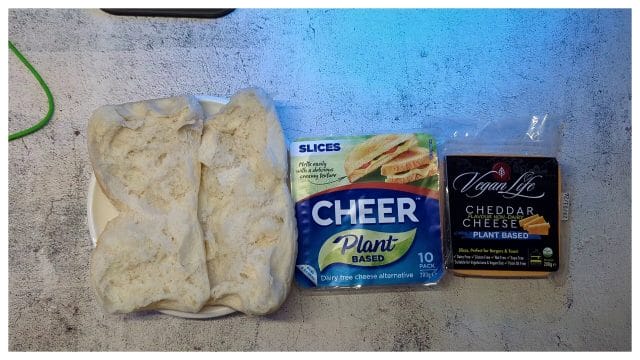
Meet the Contenders: Cheer Plant‑Based vs Vegan Life
Our two slices come from well‑known and emerging corners of the plant‑based aisle:
- Cheer Plant‑Based Cheese: Cheer is known for its classic dairy cheese heritage, and its plant‑based slices aim to deliver that familiar, fast‑food‑friendly cheddar hit. The brand’s vegan offering often targets meltability and bold savoury notes—ideal for burgers and toasties.
- Vegan Life Slices: A newer arrival that you can pick up at Woolworths, Vegan Life brings a gentler, lighter slice to the table. If you’ve tried several vegan cheeses, you’ll know some lean mild for versatility, while others push strong, sharp flavours. Vegan Life appears to sit in that easy‑going, mild camp.
Though both are marketed as cheddar‑style plant‑based cheese, they take noticeably different approaches. That’s immediately apparent the moment the packs are opened and the slices laid side‑by‑side on the counter.
First Impressions: Colour and Confidence
One of the first things you’ll notice with vegan cheese is how much colour can influence expectation. A slice that’s pale suggests a subtler flavour profile, while a deep yellow evokes the nostalgic “American‑style” burger cheese vibe many of us associate with fast food joints.

In this case, one slice presents a very light colour—almost off‑white with a faint yellow tint—while the other is distinctly more yellow. Colour isn’t flavour, of course, but there’s psychology at play: a brighter, warmer hue primes the mind for punchy cheddar notes. Think of the slices you’d find in a burger chain’s kitchen: assertively yellow, glossy, and sized for a bun.
Opening the Pack: Practicalities at Play
If you’ve tried plant‑based slices before, you’ll know packaging can be a minor hurdle. Some packs stick together or tear in ways that make it fiddly to extract a single slice cleanly. In our test, the Vegan Life pack needed a moment—“Finally I’ve opened it up”—which is relatable if you’ve wrestled with clingy plastic or tight reseals. Once free, the slice is ready to compare colour, thickness, and size against the Cheer counterpart.
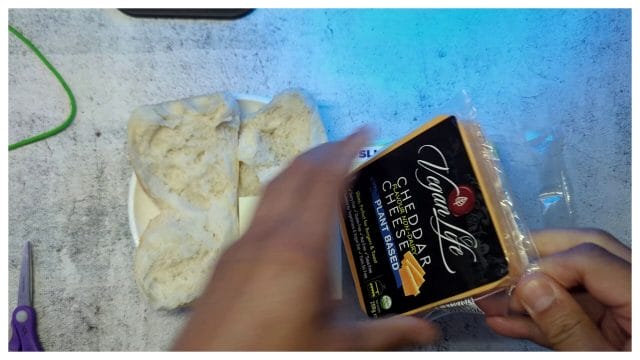
Packaging is more than just frustration: it can affect freshness, ease of portioning, and the way slices separate. Good reseals and consistent slice spacing keep edges intact and prevent tearing, which matters when you’re laying slices on burgers or layering them into toasties. Cheer’s pack design tends to feel familiar and robust; Vegan Life’s pack, being newer, may vary by batch and store.
Appearance and Size: Burger‑Ready vs Breakfast‑Mild
Once both slices are laid out, the differences sharpen. The more yellow slice looks, frankly, like the kind you’d get from Hungry Jack’s—fast‑food, burger‑ready, and sized generously. The other slice—the lighter one—feels more delicate in both colour and posture.
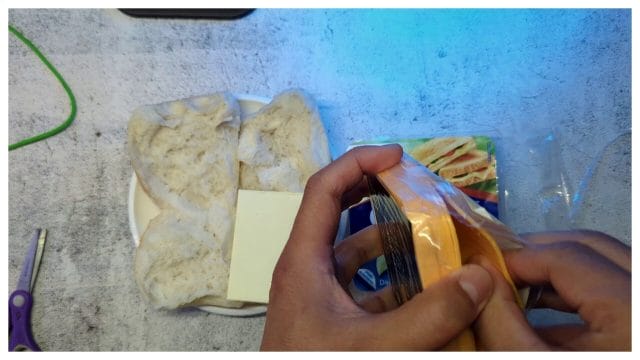
If you’re assembling a plant‑based burger, a larger, punchier slice can make a huge difference. The way cheese drapes over a patty, melts around the edges, and gives that glossy finish is part of the classic burger experience. A brighter yellow slice tends to suggest that performance. Conversely, the smaller, lighter slice may be perfect for breakfast wraps, toast toppers, or grilled sandwiches where subtlety is the goal and you don’t want the cheese to dominate.
Thickness matters too. Thicker slices often deliver a more satisfying melt when heated gently, while thinner slices can crisp more quickly under direct heat. This plays directly into the toaster test below, where heat exposure turns one of the slices crunchy at the edges while the other remains mild and less impactful.
Aroma and Anticipation
Vegan cheese aroma varies greatly. Some brands lean into lactic‑like tang via acidity regulators, while others use yeast extracts, natural flavourings, and even smoke notes to mimic cheddar. Opening the pack gives you the first hint: a stronger savoury aroma usually signals a more pronounced taste. In this comparison, the yellower slice comes off as more confident—from colour to scent—while the lighter slice remains restrained. For those who’ve tried nutritional yeast‑based spreads, you’ll recognise that nutty, umami backbone some vegan cheeses develop. Stronger slices often carry it; milder ones sit back.
The Heat Test: Toaster Trials and Melting Reality
“Okay, I’m just gonna put it in the toaster” isn’t the standard method many of us would recommend for cheese, but it’s a revealing, real‑world prompt. When you slide a slice into a toaster or pop it onto toast and heat it directly, you test how the cheese behaves under quick, dry heat. Does it melt? Crisp? Stay soft? Separate? These behaviours come down to ingredients like coconut oil, potato starch, tapioca, and emulsifiers.

In this quick trial, the result was crunchy edges and a noticeable cheddar punch for the more yellow slice—consistent with a “fast‑food cheese” profile. The Vegan Life slice, by contrast, “couldn’t really taste that much,” with feedback that it “didn’t have much flavour.” In other words, under dry heat and short exposure, one slice asserts itself; the other keeps a lower profile.
It’s worth noting that many vegan cheeses melt best with gentler, moist heat. Covering a toasted sandwich to trap steam, cooking low and slow, or using a lid on a frying pan can transform performance. Dry heat can make slices crisp or even bubble oil without achieving that gooey meld. The toaster is a harsh proving ground—great for a quick experiment, but not always reflective of optimal cooking.
Why Do Vegan Cheeses Taste So Different?
Under the hood, vegan cheeses vary in fat sources, starches, and flavour compounds:
- Oils: Coconut oil is common for structure and mouthfeel, but it can be less melty under direct dry heat. Some brands blend coconut with canola or sunflower for different melt characteristics.
- Starches: Potato and tapioca starch help bind and mimic stretch. The balance determines whether a slice melts smoothly or firms up.
- Acidity and Umami: Lactic acid (non‑dairy), citric acid, yeast extracts, and natural flavourings provide tang and savouriness. Stronger cheddar‑style slices push these elements to the fore.
- Fortification: Many vegan cheeses add calcium and vitamin B12. Fortification affects nutrition rather than flavour, but it’s a bonus for plant‑based diets.
Cheer’s plant‑based slice, with its bold colour and fast‑food leanings, likely emphasises savoury flavourings and a melt profile aimed at quick‑service cooking. Vegan Life, being milder, may prioritise a clean ingredient list or lower intensity for broad use—sandwiches, wraps, and snacks where cheese acts as a supporting note.
Taste and Texture: Cheddar Hit vs Mellow Mild
On the palate, the difference is clear:
- Cheer Plant‑Based: A noticeable cheddar flavour. Expect a salty‑umami base, a bit of tang, and that familiar “burger cheese” presence. The texture leans smooth when warmed and slightly firm when cold, with crispness possible under very dry heat.
- Vegan Life: Much milder. This can be a pro or con depending on context. The palate gets a gentle savouriness rather than a cheddar punch. Cold, it may feel a touch more pliable and less assertive. Warmed properly (with steam or gentle heat), it can soften nicely without taking over.
When we say “didn’t have much flavour,” we’re speaking within the comparison. Vegan Life isn’t flavourless; it’s simply understated next to a slice designed to mimic fast‑food cheddar intensity. Many people actually prefer milder slices for breakfast or layered sandwiches, especially when other ingredients—tomato, chutney, pickles—do the heavy lifting.
Melting Matters: Getting the Best Out of Each Slice
Vegan cheese doesn’t always melt like dairy, but you can coax much better performance with technique:
- Low and slow: Reduce heat slightly and give the slice time to soften. Rapid, high heat can make vegan cheese separate or crisp.
- Add moisture: Cover your pan or toastie press briefly to trap steam. A tiny splash of water and a lid can boost melt.
- Pre‑grate or tear: Smaller pieces melt more evenly than a single thick slab.
- Layer smart: Place cheese between moist ingredients (like tomato or sautéed mushrooms) to encourage softening.
- Combine with spreads: A thin swipe of vegan mayo or mustard beneath the slice can improve texture and meld.
If you’re craving that classic burger melt, the Cheer slice’s bright profile and size make it a natural candidate. For toasties or wraps where you want subtle creaminess, Vegan Life’s milder character may be just right—especially with steam assist and lower heat.
Real‑World Uses: Where Each Slice Shines
Cheer Plant‑Based: Bold, Burger‑Friendly
Place a Cheer slice on a hot patty and cover the pan for 30–45 seconds: you’ll often get a glossy, satisfying melt that hugs the edges. Its flavour stands up to pickles, onions, ketchup, and mustard—the classic burger ensemble. In toasties, it brings that nostalgic, processed‑cheese comfort, ideal with sliced tomato and a dab of brown sauce. It’s also great for loaded nachos where you want a strong savoury base before adding jalapeños and salsa.
Vegan Life: Mild, Versatile, Easy to Pair
Vegan Life works beautifully where you want creaminess but not domination. Think breakfast wraps with sautéed spinach, a thin slice of tomato, and a sprinkle of salt and pepper. In a grilled sandwich with chutney or pesto, the mildness lets your condiments sing while adding gentle body. Kids who are sensitive to strong flavours may prefer it, and it’s handy for office lunches where you don’t want overpowering aromas.
Ingredients, Nutrition, and Allergen Notes
While exact ingredient lists vary by region and batch, most vegan slices share some common components:
- Base: Oils (often coconut), water, and starches (tapioca, potato) form structure and mouthfeel.
- Flavourings: Yeast extract, natural flavours, acidity regulators (like lactic acid) to emulate cheddar tang.
- Fortification: Calcium salts and vitamin B12 are common additions, supporting plant‑based nutrition.
- Allergens: Many slices are soy‑free and dairy‑free; some may contain nuts or be produced in facilities handling allergens. Always check labels.
One nutritional note: coconut‑oil‑based slices can be higher in saturated fat. That doesn’t make them “bad” outright, but it’s worth balancing with whole foods—greens, beans, whole grains—and using slices as part of a broader, varied diet. If you’re looking for lower‑sodium options, milder slices often run slightly lighter on salt, though always confirm specifics on the pack.
Price and Availability
Availability and pricing vary by store and location. Vegan Life is noted as available at Woolworths in the test, suggesting easy supermarket access. Cheer’s plant‑based slices are also generally found in mainstream supermarkets. Prices can fluctuate based on promotions and regional supply, so it’s worth browsing both and deciding based on your taste and cooking style.
Texture, Mouthfeel, and Aftertaste
Texture is a key part of the cheese experience. Cold from the fridge, plant‑based slices can feel firmer or waxier than dairy, but warming smooths the mouthfeel. The Cheer slice leans silky when heated properly and gives that satisfying cling to bread or patties. Vegan Life remains softer and less assertive, making it pleasant when you want the cheese to be a gentle binder rather than the star. Aftertaste matters too: stronger slices may linger with savoury notes; milder ones clear quickly, which some prefer for everyday sandwiches.
Cooking Tips for Better Vegan Cheese
- Toasties: Layer cheese between moist fillings, toast on medium, and press gently. Finish with a minute under a covered pan if needed.
- Burgers: Add the slice as the patty nears done, cover with a lid, and let steam work its magic for 30–45 seconds.
- Grilled veg: Top roasted peppers or mushrooms with a slice at the end and broil briefly, watching for softening rather than browning.
- Pasta bakes: Shred slices and mix with plant milk and a little mustard, then bake covered until creamy.
- Quesadillas: Tear up slices for more even melt, cook low and slow, and cover between flips.
Flavour Pairings to Elevate Each Slice
Cheer Plant‑Based
- Condiments: Ketchup, mustard, BBQ sauce—classic burger accompaniments.
- Veg: Pickles, onions (raw or caramelised), lettuce, tomato.
- Extras: Vegan bacon, jalapeños, hot sauce; the slice’s strength holds up well.
Vegan Life
- Condiments: Pesto, chutney, olive tapenade—these shine against a mild base.
- Veg: Avocado, spinach, roasted courgette, sliced cucumber.
- Extras: Fresh herbs (basil, chives), lemon zest, a sprinkle of smoked paprika for warmth.
Common Pitfalls (and How to Avoid Them)
- Drying out under high heat: Lower the heat and add steam; cover briefly to encourage melt.
- Uneven softening: Tear or grate slices for uniform melting, especially in larger sandwiches or bakes.
- Plastic‑like texture: Gentle heat and moisture soften starches and oils, reducing that firm edge.
- Overpowering flavour clash: For strong slices, balance with simple condiments; for mild slices, add punchy chutney or pickles.
A Quick Note on the Toaster Test
Using a toaster for cheese is not a typical method—most toasters aren’t designed for direct cheese melting, and it can get messy. If you want crisp edges and a quick test without faff, a toaster experiment will show whether a slice asserts itself under dry heat. But for the melt most of us actually want, use a frying pan, grill, or toastie maker with a lid to trap steam. The crunchy comment in the video makes perfect sense given dry heat exposure; that crunch can be lovely on the right day, but it’s not the gooey melt you’d expect on a burger or toastie.
The Verdict: Which Slice Wins?
It depends what you want from your plant‑based cheese:
- If you crave classic burger‑style cheddar: Go for the Cheer plant‑based slice. Its bold colour, larger size, and pronounced flavour are tailor‑made for burgers, loaded toasties, and dishes where cheese should shout.
- If you prefer versatile, mild creaminess: Pick Vegan Life. It’s less punchy but gentle and accommodating, perfect for breakfast wraps, office sandwiches, and pairings with flavourful condiments where cheese is the supporting act.
The live feedback—“I can really taste the cheddar for this one” versus “didn’t have much flavour”—captures the core difference. We’d place Cheer in the “fast‑food friendly” camp and Vegan Life in the “weekday versatile” camp. If budget allows, keep both in the fridge: one for weekend burgers, one for everyday wraps and toast.
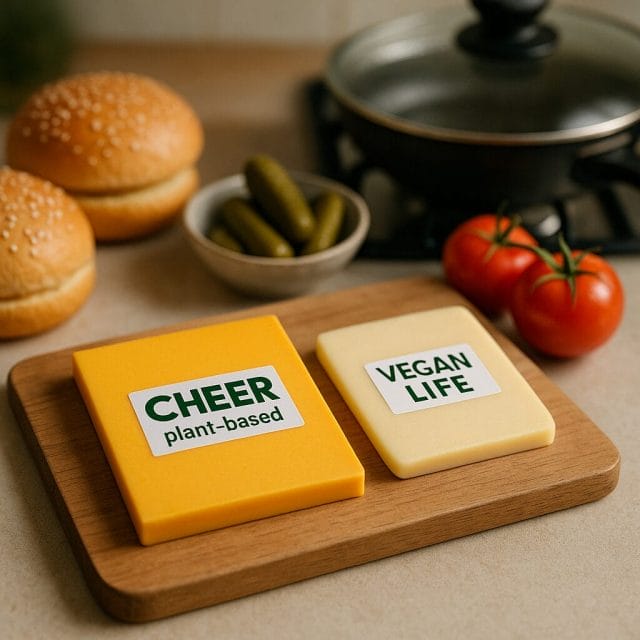
FAQs and Final Tips
Do these slices brown like dairy cheese?
Not usually. Vegan slices often soften and gloss rather than brown. If browning is your goal, use a grill and watch closely, but accept that the effect will be subtler than dairy.
Can I use them in mac and cheese?
Yes—tear or grate, then melt with a splash of plant milk and a teaspoon of mustard or miso for umami. Cheer brings bolder flavour; Vegan Life offers silky mildness.
Do they stretch like mozzarella?
Cheddar‑style slices aren’t built for stretch. If you want pull, look for dedicated vegan mozzarella designed for pizza, often with different starch/oil ratios.
What’s the best way to store?
Keep sealed in the fridge and use by the date. Reseal carefully to prevent drying at the edges. If slices stick, chill them well before separating.
Closing Thoughts
The simplest tests often teach the most. A quick run through the toaster showed clear personality differences between Cheer’s plant‑based slice and Vegan Life’s milder option. Colour, size, and flavour intensity line up with real‑world cooking needs: some days you want that Hungry Jack’s‑style, burger‑worthy cheddar punch; other days you want a gentle, creamy layer that lets your chosen condiments do the talking. Both slices have a place in a plant‑based kitchen, and with a few melting tricks—lower heat, a bit of steam, smart layering—you can get a satisfying result every time.
If you’re new to vegan cheese, start with a dish you love. Turn a favourite burger or toastie plant‑based using the Cheer slice for boldness; later, try Vegan Life for a mild wrap where the texture matters more than the flavour intensity. Ultimately, the “best” vegan cheese isn’t just the one that tastes strongest—it’s the one that fits your routine, your recipes, and the way you enjoy food at home.
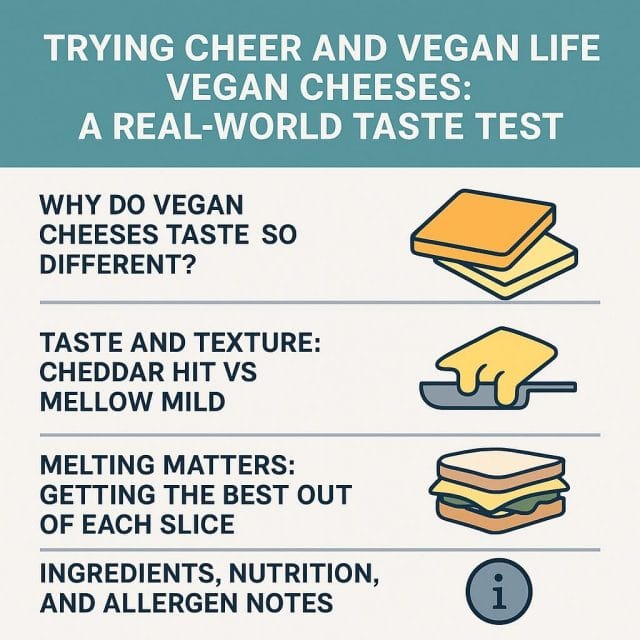

If this article helped you in any way and you want to show your appreciation, I am more than happy to receive donations through PayPal. This will help me maintain and improve this website so I can help more people out there. Thank you for your help.





